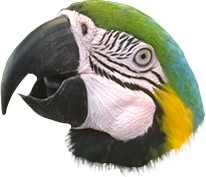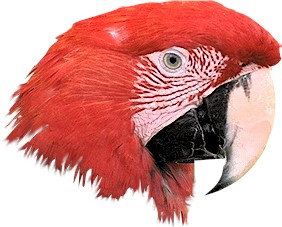 |
| Home |
| Who We Are |
| Save The Parrots |
| Books |
| Links |
| Volunteers |
| Articles |
| Avian Vet Listing |
| Email Us |


Box 13, Point Arena, CA 95468 USA
PH: (213) 819-1723
macaws@parrotpro.com
DIMORPHISM - THE EASIEST METHOD (Webster: The existence of two types, exclusive of sex, in the same species, distinct in coloring, size, etc.)
Many of the birds we are raising have no distinct differences between the sexes. The first thing to do is to determine the exact species and/or subspecies you are dealing with, and go from there. An up-to-date reference book is a big help at this stage.
A good book on the individual family or species is best, and failing that, a good book on the general subject is next. (Forshaw, Parrots of the World lists almost all known parrot types and their sub-species and is a valuable reference in this matter).
Some Cockatoos have differences in eye color that can be compared. In some mature birds, males and females may have different color patterns; Blue-hainging Parrots are quite different as adults, but adolescent males look like females until they mature. Parakeets have a different color cere; adult males are normally blue adult females brown. This can change, however, if there are abnormalities in health or condition. With dimorphic birds, most have to be adults before you can detect differences. In some, such as the tiny Parrotlets, differences are obvious as soon as the babies begin to show color.
If your bird is an adult and has been through several hands prior to your ownership, check under the wings for a tattoo. If a smudge of ink has been injected under the right wing, it is supposed to be a male, under the left wing, a female. I say "supposed to", because the presence of a tattoo is by no means a guarantee that the sex of the bird was actually determined prior to the tattoo. Unfortunately, some people discovered that they could get a few dollars more for a "sexed" bird that carried a tattoo, and many birds have been sold with only the tattoo. An experienced aviculturist will not trust sex determination on a tattoo alone.
THE GUESS METHOD
This is where you have two birds that behave like a pair; feed each other, perhaps even copulate, and you think they are opposite sexes. You have one that always takes the highest perch; there are eggs in the box; one likes only men; one likes women. Keep in mind that babies will feed each other, hens will feed each other, as will males. We hear a new "method" almost daily. None are indicators of sexual identification. (I always like to say that I will teach them to talk, then ASK them).
Sometimes someone will want to bring you a bird and let it "pick" a mate from your birds...NOT a good idea! Most of us have closed facilities, which means no strange birds in the aviaries, or perhaps on the premises. Proper quarantine procedures preclude this method. Most aspects of behavior and attitude are totally irrelevant as any kind of accurate guide to sex determination.
THE AUDUBON METHOD
Shoot one, open up, see what it ate last, what sex it was, measure the stuff, and go get another one. This will accurately determine sex, but is not particularly useful for breeding.
FECAL METHOD
This involves collecting fresh fecal samples over a period of days and laboratory processing it to determine the estrogen/testosterone levels. Here is what happened when we tried it several years ago; we collected samples as per instructions. A mature, three-year-old Conure's results came back as a male; she laid eggs within a year. A mature Amazon, nine-years-old, came back as another male; this one also laid within a year. A twelve-year-old Macaw was reported to be a male, and later surgical sexing confirmed this. The laboratory did give us a refund on the two incorrect results, but there was an obvious delay in properly pairing up these birds.
PELVIC EXAM METHOD

Here the discussion is limited only to Macaws, as this is where we keep track of our guesses. For use when making a determination if a bird cannot be sexed before purchase, and you just can't pass it up. If you are faced with three hundred birds at a quarantine station and you are trying to pick pairs, this can be helpful. It is accurate about 70% of the time, for us. Located around the vent, "pelvic structure" in a mature bird seems to vary. If you cannot pass your finger between the opening of the pelvic bones, just behind the vent, it may be a male. If a finger passes easily between the bones, it is likely to be a female. This is based on the principle that an egg must also pass through the opening. We use the "pelvic feel" as a PRELIMINARY GUIDE. Also, the bones are somewhat more rounded on the ends if a female.
CHICKEN SEXING
An easy way to sex poultry that is fast, safe, and reliable is a method used for baby chicks. One day old chicks whose wing feathers are even are males, those whose wings have long and short feather are females.
SURGICAL SEXING
First, this should ONLY be done by a QUALIFIED AVIAN VETERINARIAN who does numerous sexings without serious incident. The surgery involves anesthesia. There are two types commonly used; one that is injectable, has been around for years, and is more convenient for many veterinarians who have not yet purchased the newer and more expensive anesthesia units for gas anesthesia. The birds stay asleep much longer, and can go through a rough awakening period of thrashing and/or vomiting. The other choice is isoflurine gas. It is more expensive and requires specialized equipment, but the results are dramatically different. The birds are out for only that time required to perform the surgery and wake up quickly and are as alert as when they went in. Used by a skilled avian veterinarian, it is a very safe method. After having been through both kinds with my birds, I would never go back to anyone who does not use the isoflurine.
The surgery itself involves putting the bird to sleep, plucking a small area of feathers from the site of choice, and making a small incision. An endoscope is inserted into the incision and the gonads are visualized to determine if they are ovaries or testicles. If the birds are to be tattooed, this can be done at this time. Many veterinarians band the bird, left or right leg, to identify sex. One newer method is the electronic implant. It does not catch on wire as a leg band might, it does not fade or drift, as tattoos do, and the information can easily read merely by aiming the "gun" at the bird and reading display.
Keep an eye on the birds for a few days after surgical sexing. I recommend that they be kept indoors and quiet. I trim a wing-tip (left or right), to aid in visual identification and minimize handling. Check the tattoo, incision, and the stitch, if one is used, before re-installing the birds into a flight.
CHROMOSOME ANALYSIS
Chromosome analysis is non-surgical, 100% accurate, and eliminates the risks associated with surgery. It can be done by mail, so if you can get to a post office, you can have it done. The disadvantage of this as opposed to surgical sexing is that the veterinarian cannot actually visualize the internal workings of that bird and if the bird has severely atrophied gonads, candida, aspergillosis, or any other disease that can at times be determined by visual examination, you may never know it.
To collect material for this test, you need to pull either a blood feather (one that is still growing and is filled with blood and pulp, like a capsule), or pull some large tail feather so new ones will begin to grow. When they are grown out enough to safely pull them, these will be your samples. It can take two to three weeks to obtain a sample if you have to do it this way.
When the new feather is beginning to grow, call the laboratory and tell them how many birds there are to be sexed, what species, and your name, telephone number and postal address. I use Mark Valentine in Memphis, so I often have to leave this information on an answering machine.
Mark sends a styrofoam box by priority mail. Inside is a cold-pack, complete directions, expiration date, and as many tubes (filled with liquid) as you will need, using one per bird. This only takes two days to reach you, so if it is delivered to a post office, don't leave it sitting around. The cold pack will need to be re-frozen and the tubes with their fluid contents will need to be refrigerated. It has a shelf life of about 30 days.
You will need alcohol, scissors, a cotton ball, and a pair of pliers. Everything gets cleaned in the alcohol. Hold the bird comfortably in a towel ( I prefer to use two people for this job), and use the pliers to ease the feather out. Don't go too slow, or you will hurt the bird; too fast, and you may tear the blood feather and start a mess. Make sure the feather is grown out enough so that you can get a good purchase on it with the pliers. If the follicle bleeds, pinch it with your fingers for a minute or two. Peroxide cleans up blood very nicely on both birds and clothing.
Once you have the feather, cut the feather capsule just below the emerging feather barbs and drop it in the tube. NEVER touch the feather end or lay it down. Make sure each sample is properly labeled and mail it back, overnight express to the lab. Try to mail it early in the week so the package does not arrive on a weekend.
The tissue is grown in a culture, which takes seven to fourteen days, and the sample is stained to show chromosomes under a microscope. You will get a phone call and if requested, a follow up letter for your files. The address for Mr. Valentine is: c/o the Medicine Shop, Avian Genetic Sexing Lab., 4394 Summer Avenue, Memphis, Tennessee 38122. Usual cost for this service is $35 to $50.